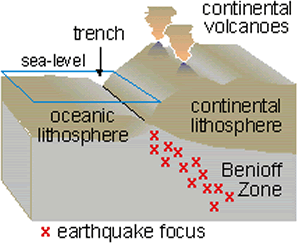
A dipping planar (flat) zone of earthquakes that is produced by the interaction of a downgoing oceanic crustal plate with a continental plate. These earthquakes can be produced by slip along the subduction thrust fault or by slip on faults within the downgoing plate as a result of bending and extension as the plate is pulled into the mantle. These zones are called Wadati-Benioff zones after two of the seismologists who first recognized them, Kiyoo Wadati of Japan and Hugo Benioff of the United States.
Wadati-Benioff zones are found in subduction zones that form by the collision of two crustal plates of dissimilar density and thickness, for example an oceanic and continental plate. The heavier (thinner) crust of the oceanic plate is subducted under the lighter and much thicker crust of the continental plate. A deep ocean trench is produced where these two plates meet. Along the Peru-Chile trench, the Pacific plate is being subducted under the South American plate, which responds by crumpling to form the Andes. The earthquake zones that parallel the great oceanic trenches are typically inclined from 40 to 60 degrees from the horizontal and extend several hundred kilometers into the mantle along trends that reach thousands of kilometers in length.

